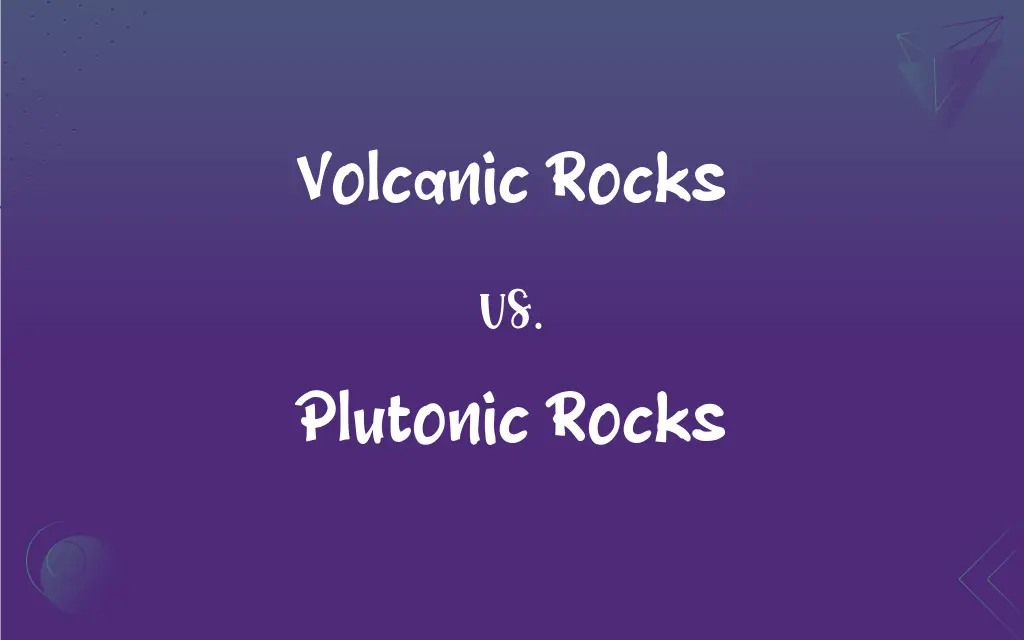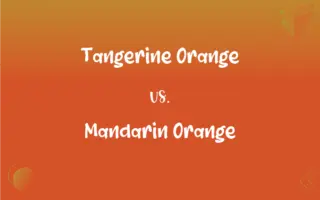Volcanic Rocks vs. Plutonic Rocks: What's the Difference?
Edited by Aimie Carlson || By Janet White || Published on February 22, 2024
Volcanic rocks form from lava on Earth's surface, exhibiting fine grains and rapid cooling. Plutonic rocks crystallize slowly beneath the surface, characterized by coarse grains.

Key Differences
Volcanic rocks, also known as extrusive igneous rocks, are formed from lava that cools and solidifies on the Earth's surface, resulting in fine-grained textures. Plutonic rocks, or intrusive igneous rocks, crystallize slowly beneath the Earth's surface from magma, leading to a coarse-grained texture.
The cooling rate of volcanic rocks is rapid, due to exposure to the atmosphere or water, which often leads to the formation of small crystals or a glassy texture. In contrast, plutonic rocks cool slowly underground, allowing time for large crystals to grow, resulting in a visibly granular structure.
Volcanic rocks are typically less dense and may contain voids or vesicles created by trapped gas bubbles during rapid cooling. Conversely, plutonic rocks are denser and solid, lacking such voids due to their slow crystallization process underground.
Common examples of volcanic rocks include basalt and andesite, which are often found at or near volcanic sites. Plutonic rocks are exemplified by granite and gabbro, commonly found in deeper crustal areas or exposed by erosion.
The mineral composition of volcanic rocks can vary widely, but they often have higher amounts of volatile components due to their formation at the surface. Plutonic rocks, on the other hand, typically have lower volatile contents and a composition that reflects deeper Earth processes.
ADVERTISEMENT
Comparison Chart
Formation Location
At or near the Earth's surface
Beneath the Earth's surface
Cooling Rate
Rapid
Slow
Texture
Fine-grained or glassy
Coarse-grained
Density
Generally lower
Generally higher
Common Examples
Basalt, Andesite
Granite, Gabbro
ADVERTISEMENT
Volcanic Rocks and Plutonic Rocks Definitions
Volcanic Rocks
Rocks that solidify from lava, characteristically having small crystals.
Obsidian, a type of volcanic rock, has a smooth glassy appearance.
Plutonic Rocks
Coarse-grained igneous rocks formed deep within the Earth.
Diorite, a plutonic rock, is commonly found in continental crust.
Volcanic Rocks
Rocks formed from the cooling of lava at the Earth's surface.
The basalt columns at the beach are an example of volcanic rocks.
Plutonic Rocks
Rocks that crystallize slowly beneath the Earth's surface from magma.
The granite in the kitchen countertop is a type of plutonic rock.
Volcanic Rocks
Surface-formed igneous rocks, often rich in volatile components.
Scoria, a type of volcanic rock, is commonly found near volcanoes.
Plutonic Rocks
Intrusive igneous rocks characterized by large, visible crystals.
Gabbro, a plutonic rock, is often used in construction due to its durability.
Volcanic Rocks
Extrusive igneous rocks, often associated with volcanic activity.
Volcanic rocks like pumice are lightweight and porous.
Plutonic Rocks
Rocks formed underground, typically with lower volatile contents.
The plutonic rock in the mountain range is predominantly granite.
Volcanic Rocks
Igneous rocks with a fine-grained or glassy texture due to rapid cooling.
The volcanic rocks in the area are mostly andesite.
Plutonic Rocks
Dense and solid igneous rocks, contrasting with volcanic rocks.
The quarry is known for its high-quality plutonic rock deposits.
FAQs
What are volcanic rocks?
Rocks formed from lava cooling on the Earth's surface.
How are volcanic rocks identified?
By their fine-grained texture and often porous nature.
Can volcanic rocks float?
Some types, like pumice, can float due to their porosity.
What are plutonic rocks?
Rocks that form from magma cooling slowly beneath the surface.
Do volcanic rocks form only at volcanoes?
Mostly, but they can also form in other areas with volcanic activity.
How do plutonic rocks differ in appearance from volcanic rocks?
They have a coarse-grained texture with visible crystals.
Are plutonic rocks harder than volcanic rocks?
Generally, yes, due to their dense and solid structure.
Are volcanic rocks always dark in color?
No, their color can vary based on mineral content.
What causes the different textures in volcanic and plutonic rocks?
The rate of cooling of the lava or magma.
Is granite a plutonic rock?
Yes, granite is a common example of a plutonic rock.
Is obsidian a volcanic rock?
Yes, obsidian is a type of volcanic glass.
Are volcanic rocks rich in minerals?
They can be, depending on their composition.
Can volcanic rocks be colorful?
Yes, they can have various colors based on mineral composition.
Are all plutonic rocks intrusive?
Yes, by definition, plutonic rocks are intrusive igneous rocks.
Do plutonic rocks contain fossils?
No, they typically do not contain fossils.
Do plutonic rocks form above ground?
No, they form beneath the Earth's surface.
Can volcanic rocks be used in construction?
Yes, some types like basalt are used in construction.
Why are plutonic rocks often used for countertops?
Due to their durability and aesthetic appearance.
Can plutonic rocks be found on the surface?
Yes, but typically due to erosion or tectonic activity.
Do volcanic rocks cool quickly or slowly?
Volcanic rocks cool quickly compared to plutonic rocks.
About Author
Written by
Janet WhiteJanet White has been an esteemed writer and blogger for Difference Wiki. Holding a Master's degree in Science and Medical Journalism from the prestigious Boston University, she has consistently demonstrated her expertise and passion for her field. When she's not immersed in her work, Janet relishes her time exercising, delving into a good book, and cherishing moments with friends and family.
Edited by
Aimie CarlsonAimie Carlson, holding a master's degree in English literature, is a fervent English language enthusiast. She lends her writing talents to Difference Wiki, a prominent website that specializes in comparisons, offering readers insightful analyses that both captivate and inform.







































































